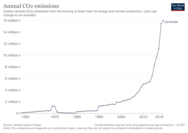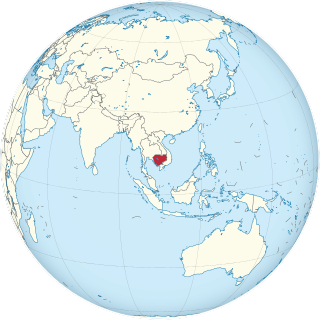
Cambodia is a country in mainland Southeast Asia. It borders Thailand, Laos, Vietnam, the Gulf of Thailand and covers a total area of approximately 181,035 km2 (69,898 sq mi). The country is situated in its entirety inside the tropical Indomalayan realm and the Indochina Time zone (ICT).
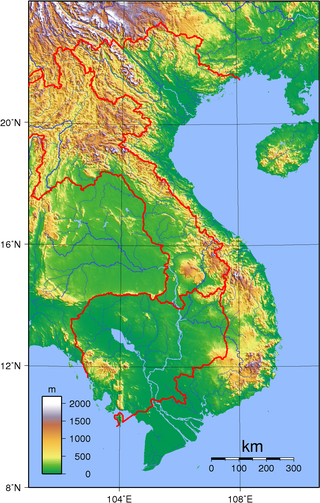
Vietnam is located on the eastern margin of the Indochinese peninsula and occupies about 331,211.6 square kilometres (127,881.5 sq mi), of which about 25% was under cultivation in 1987. It borders the Gulf of Tonkin, Gulf of Thailand, and Pacific Ocean, along with China, Laos, and Cambodia. The elongated roughly S shaped country has a north-to-south distance of 1,650 km (1,030 mi) and is about 50 km (31 mi) wide at the narrowest point. With a coastline of 3,260 km (2,030 mi), excluding islands, Vietnam claims 12 nautical miles as the limit of its territorial waters, an additional 12 nautical miles as a contiguous customs and security zone. It has an exclusive economic zone of 417,663 km2 (161,261 sq mi) with 200 nautical miles.

The Mekong or Mekong River is a trans-boundary river in East Asia and Southeast Asia. It is the world's twelfth-longest river and the third-longest in Asia with an estimated length of 4,909 km (3,050 mi) and a drainage area of 795,000 km2 (307,000 sq mi), discharging 475 km3 (114 cu mi) of water annually. From its headwaters in the Tibetan Plateau, the river runs through Southwest China, Myanmar, Laos, Thailand, Cambodia, and southern Vietnam. The extreme seasonal variations in flow and the presence of rapids and waterfalls in the Mekong make navigation difficult. Even so, the river is a major trade route between Tibet and Southeast Asia. The construction of hydroelectric dams along the Mekong in the 2000s through the 2020s has caused serious problems for the river's ecosystem, including the exacerbation of drought.

Tonlé Sap (; Khmer: ទន្លេសាប, Tônlé Sab ; lit. 'Fresh River' or commonly translated as 'Great Lake' is a lake in the northwest of Cambodia. Belonging to the Mekong River system, Tonlé Sap is the largest freshwater lake in Southeast Asia and one of the most diverse and productive ecosystems in the world. It has been designated as a Biosphere Reserve by UNESCO in 1997 due to its high biodiversity. In the 21st century, the lake and its surrounding ecosystems are under increasing pressure from deforestation, infrastructure development and climate change.

Climate change is an urgent and significant issue affecting Japan. In recent years, the country has observed notable changes in its climate patterns, with rising temperatures serving as a prominent indicator of this phenomenon. As an archipelago situated in northeastern Asia, Japan is particularly vulnerable to the impacts of climate change due to its diverse geography and exposure to various weather systems. The nation experiences a broad range of climates, spanning from the frigid winters of Hokkaido to the subtropical climates of Okinawa. Changes in temperature patterns have the potential to disrupt ecosystems, impact agricultural productivity, modify water resources, and pose significant challenges to infrastructure and human settlements.
This page describes energy and electricity production, consumption and import in Laos.
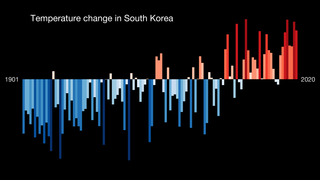
Climate change has led to extreme weather events in South Korea that affects: social, economy, industry, culture, and many other sectors. South Korea is experiencing changes in climate parameters. Such parameters include annual temperature, rainfall amounts, and precipitation.

Climate change is predicted to have significant effects on the living conditions in Argentina. The climate of Argentina is changing with regards to precipitation patterns and temperatures. The highest increases in the precipitation have occurred in the eastern parts of the country. The increase in precipitation has led to more variability in precipitation from year to year in the northern parts of the country, with a higher risk of prolonged droughts, disfavoring agriculture in these regions.
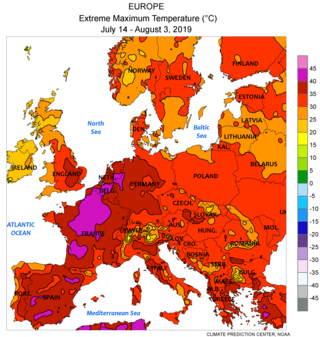
In France, climate change has caused some the greatest annual temperature increases registered in any country in Europe. The 2019 heat wave saw record temperatures of 46.0 °C. Heat waves and other extreme weather events are expected to increase with continued climate change. Other expected environmental impacts include increased floods due to both sea level rise and increased glacier melt. These environmental changes will lead to shifts in ecosystems and affect local organisms. Climate change will also cause economic losses in France, particularly in the agriculture and fisheries sectors.

In Afghanistan, climate change has led to a temperature increase of 1.8 °C since 1950. This has caused far-reaching impacts on Afghanistan, culminating from overlapping interactions of natural disasters, conflict, agricultural dependency, and severe socio-economic hardship.
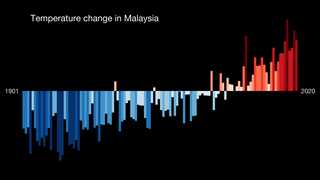
Climate change is having a considerable impact in Malaysia. Increasing temperatures are likely to greatly increase the number of heatwaves occurring annually. Variations in precipitation may increase the frequency of droughts and floods in various local areas. Sea level rise may inundate some coastal areas. These impacts are expected to have numerous environmental and socioeconomic effects, exacerbating existing environmental issues and reinforcing inequality.

Climate change in Ghana is impacting the people in Ghana in several ways as the country sits at the intersection of three hydro-climatic zones. Changes in rainfall, weather conditions and sea-level rise will affect the salinity of coastal waters. This is expected to negatively affect both farming and fisheries.

Climate change is posing an increasing threat to global socio-economic development and environmental sustainability. Developing countries with low adaptive capacity and high vulnerability to the phenomenon are disproportionately affected. Climate change in Kenya is increasingly impacting the lives of Kenya's citizens and the environment. Climate Change has led to more frequent extreme weather events like droughts which last longer than usual, irregular and unpredictable rainfall, flooding and increasing temperatures.

Vietnam is among the most affected countries by global climate change. A large number of studies show that Vietnam is experiencing climate change and will be severely negatively affected in coming decades. These negative effects include sea level rise, salinity intrusion and other hydrological problems like floods, river mouth evolution and sedimentation. Natural hazards such as cold waves, storm surges will increase in frequency, with negative effects on the country's development, infrastructure and economy.
Climate change has caused temperatures in the world to rise in the last few decades, and temperatures in Europe have risen twice as fast as the average change in the rest of the world. In Spain, which already has a hot and dry climate, extreme events such as heatwaves are becoming increasingly frequent. The country is also experiencing more episodes of drought and increased severity of these episodes. Water resources will be severely affected in various climate change scenarios.
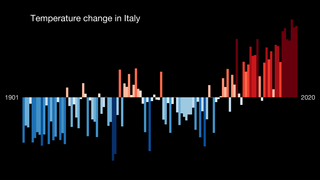
In Italy, widespread impacts of climate change are currently being felt. With an increase in extreme events such as heatwaves, droughts and more frequent flooding, Italy faces many challenges adapting to climate change.

Climate change in the Middle East and North Africa (MENA) refers to changes in the climate of the MENA region and the subsequent response, adaption and mitigation strategies of countries in the region. In 2018, the MENA region emitted 3.2 billion tonnes of carbon dioxide and produced 8.7% of global greenhouse gas emissions (GHG) despite making up only 6% of the global population. These emissions are mostly from the energy sector, an integral component of many Middle Eastern and North African economies due to the extensive oil and natural gas reserves that are found within the region. The region of Middle East is one of the most vulnerable to climate change. The impacts include increase in drought conditions, aridity, heatwaves and sea level rise.

The Tonle Sap-Mekong peat swamp forests ecoregion covers a patchwork of areas permanently inundated with fresh water along the Tonle Sap River and Mekong River floodplains in Cambodia and Vietnam. The terrain is mostly flat, with extensive agricultural fields, reed beds, and degraded shrub forest. Less than 10% of the region is in its original state, and less than 1% is protected. Habitat in the region is distinguished from the Tonle Sap freshwater swamp forests ecoregion that runs through the middle, as that ecoregion is only seasonally flooded.

Climate change impacts are occurring in Zimbabwe. Climate change is the result of the Earth's climate undergoing long-term changes due to the release of greenhouse gases like carbon dioxide (CO2) and methane (CH4). These gases trap heat in the atmosphere, leading to global warming and a hotter planet. Human activities, such as the use of fossil fuels, as well as large-scale commercial agriculture and deforestation, are responsible for the release of these greenhouse gases. The country's contribution to greenhouse gas emissions is very minimal.

Malawi is a land-locked country in southeastern Africa situated along the southernmost arm of the East African Rift-Valley System between latitudes 9°22’ and 17°03’ south of the equator, and longitudes 33°40’ and 35°55’ east of the Greenwich meridian. It shares borders with Tanzania in the north and northeast, Mozambique in the southwest, south, and east, and Zambia in the west. Malawi is highly vulnerable to the effects of climate change as the vast majority of Malawians rely on small-scale, rain-fed agriculture, making them highly dependent on weather patterns. Climate change increasingly exacerbates droughts, flooding, and inconsistent rainfall—contributing to food insecurity and threatening to derail progress toward Malawi’s goal of self-reliance.

